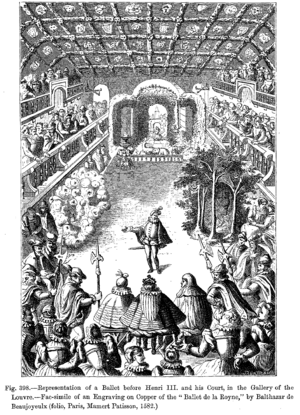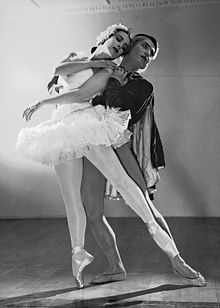Ballet Comique de la Reine

The Ballet Comique de la Reine (at the time spelled Balet comique de la Royne) was first showcased on October 15, 1581 to the court of Catherine de' Medici. The "Ballet Comique de la Reine" was created for the wedding celebration of Queen Louise's sister, Marguerite of Lorraine, who married Duc de Joyeuse. The ballet was choreographed by Balthasar de Beaujoyeulx and was the first piece to include poetry, music, design and dance, all rules of Biaf's Academie, to create a storyline. The ballet was inspired by the enchantress, Circe, from Homer's Odyssey. The pricey production lasted five and half hours and the Queen and King both participated in the performance. The Queen, along with a group of lady court dancers arrived on a fountain that was three tiers high dressed as dryads. The dancers were entering and exiting from both sides of the set, which was unusual for previous court ballets. The ballet was also made in hopes of bringing resolution to the religious hardship that caused the French people to separate. Circe was a symbol of civil war, while the restoration of peace at the end of the ballet represented the country's hopes for the future. [1][2]
Nicolas Filleul de La Chesnaye, the King's almoner, wrote the text, sets and costumes were designed by Jacques Patin.[3] The music was provided by Jacques Salmon, maitre de la musique de la chambre de Roi, and a certain "Sieur de Beaulieu." This composer was identified as "Lambert de Beaulieu" by Fétis' in his Biographie universelle, following a probable error in a letter by Rudolph II, Holy Roman Emperor, but is today identified with the bass singer Girard de Beaulieu who with his wife, the Italian soprano Violante Doria themselves sung the airs to Circé.[4]
See also
http://www.youtube.com/watch?v=XCzIWfhEOME&noredirect=1
References
Notes
- ↑ Thames & Hudson, 1988 p.14
- ↑ Anthony 1997, p. 41, and Lawrenson 1986, pp. 182–184, both identifiy the location of the performance as the Petit-Bourbon, and Lawrenson reproduces the engraving shown here. Lacroix 1876, p. 506 (the source of the image) identifies it as the "Gallery of the Louvre", and McGowan 1998, p. 275, gives "Salle de Bourbon of the Louvre". Brette 1902, pp. LIV–LXIX, discusses the history of the confusion of the location of this room in the Petit-Bourbon with the Louvre in great detail.
- ↑ Kasey Marie Mattia, Crossing the channel: Cultural identity in the court ... 2007 Duke University Page 11 "Beaujoyeulx had ultimate control over the ballet, but was assisted by Lambert Beaulieu and Jacques Salmon who composed the music, La Chesnaye who wrote the text, and Jacques Patin who designed the stage sets and costumes.
- ↑ Kristiaan Aercke -Gods of Play: Baroque Festive Performances As Rhetorical Discourse 1994 - Page 27 "... Balthasar Beaujoyeux (actually Baltazarini), with music by Lambert de Beaulieu and Jacques Salmon on a text by La Chesnaye and painted scenery by Jacques Patin (who also designed the costumes), it is the earliest such ballet of which ..
Sources
- Anthony, James R. (1997). French Baroque Music from Beaujoyeulx to Rameau, revised and extended edition. Portland, Oregon: Amadeus Press. ISBN 9781574670219.
- Brette, Armand (1902). Histoire des édifices où ont siége les assemblées parlementaires de la Révolution française et de la premère République, tome premier. Paris: Imprimerie Nationale. OCLC 457140401. View at Google Books.
- Cohen, Selma Jeanne, editor (1998). International Encyclopedia of Dance (6 volumes). Oxford: Oxford University Press. ISBN 978-0-19-509462-6 (hardcover). ISBN 978-0-19-517369-7 (2004 paperback edition).
- Graafland, Arie (2003). Versailles and the Mechanics of Power': The Subjugation of Circe. Rotterdam: 010 Publishers. ISBN 9789064504921.
- Lacroix, Paul (1876). Manners, Customs, and Dress during the Middle Ages, and during the Renaissance Period. London: Chapman and Hall. View at Google Books.
- Lawrenson, T. E. (1986). The French Stage and Playhouse in the XVIIth Century: A Study in the Advent of the Italian Order, second edition, revised and enlarged. New York: AMS Press. ISBN 9780404617219.
- McGowan, Margaret M. (1982). Le Balet Comique by Balthazar de Beaujoyeulx, 1581: A Facsimile, With an Introduction. Binghamton, New York: Medieval and Renaissance Texts. ISBN 9780866980128.
- McGowan, Margaret M. (1998). "Balet Comique de la Royne, Le" in Cohen 1998, vol. 1, pp. 275–277.
- Sharp, Cecil (1924). "The Dance, an Historical Survey of Dancing in Europe". London: Halton & Truscott Smith. OCLC 335923.
External links
-
 Media related to Ballet comique de la reine at Wikimedia Commons
Media related to Ballet comique de la reine at Wikimedia Commons - Balet comique de la Royne, copies 1 and 2 at Gallica.
- "Le Balet Comique de la Reine, 1581: An Analysis" by Elizabeth Cooper at the Wayback Machine (archived June 4, 2011)
| ||||||||||||||||||||||||||||||||||||
